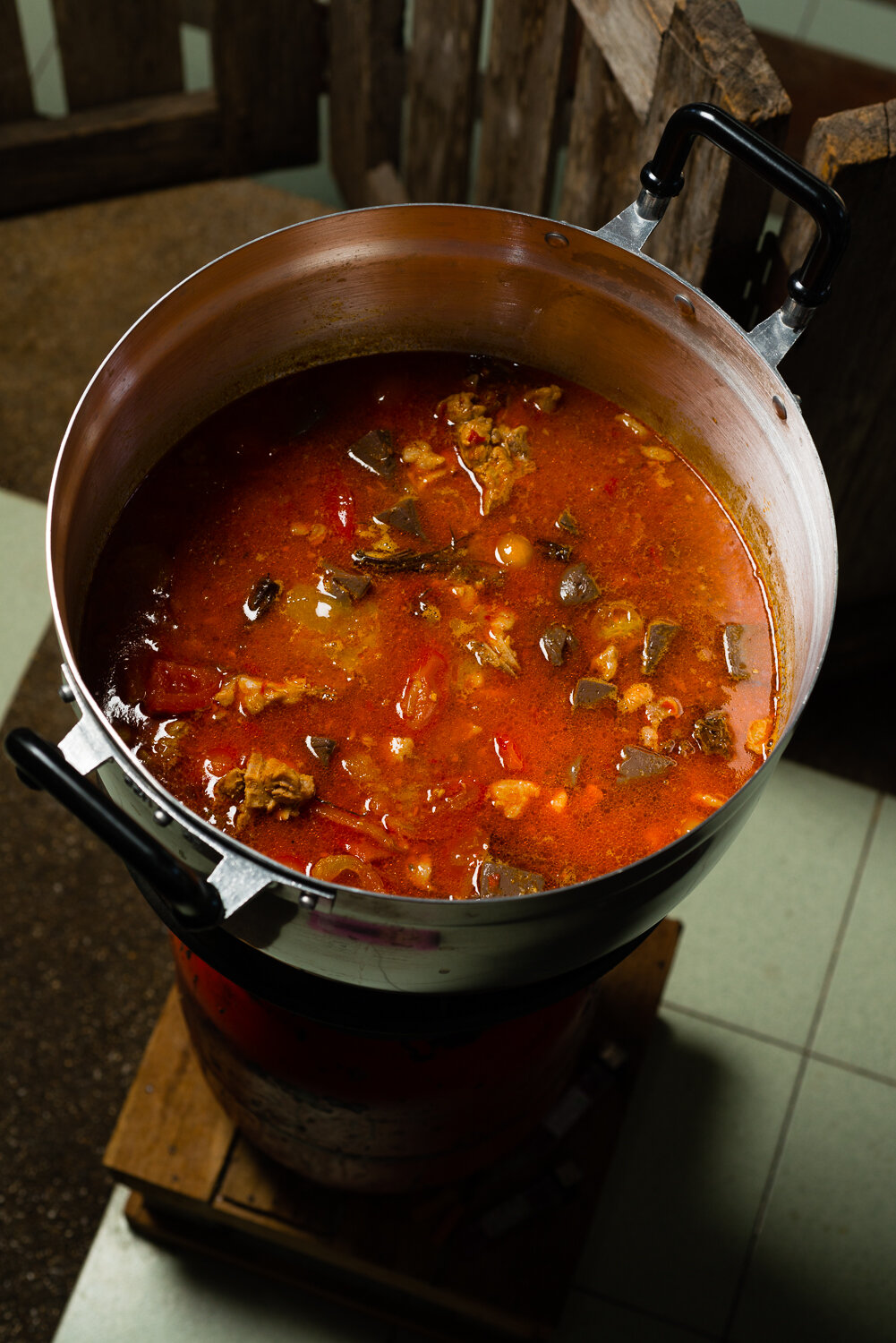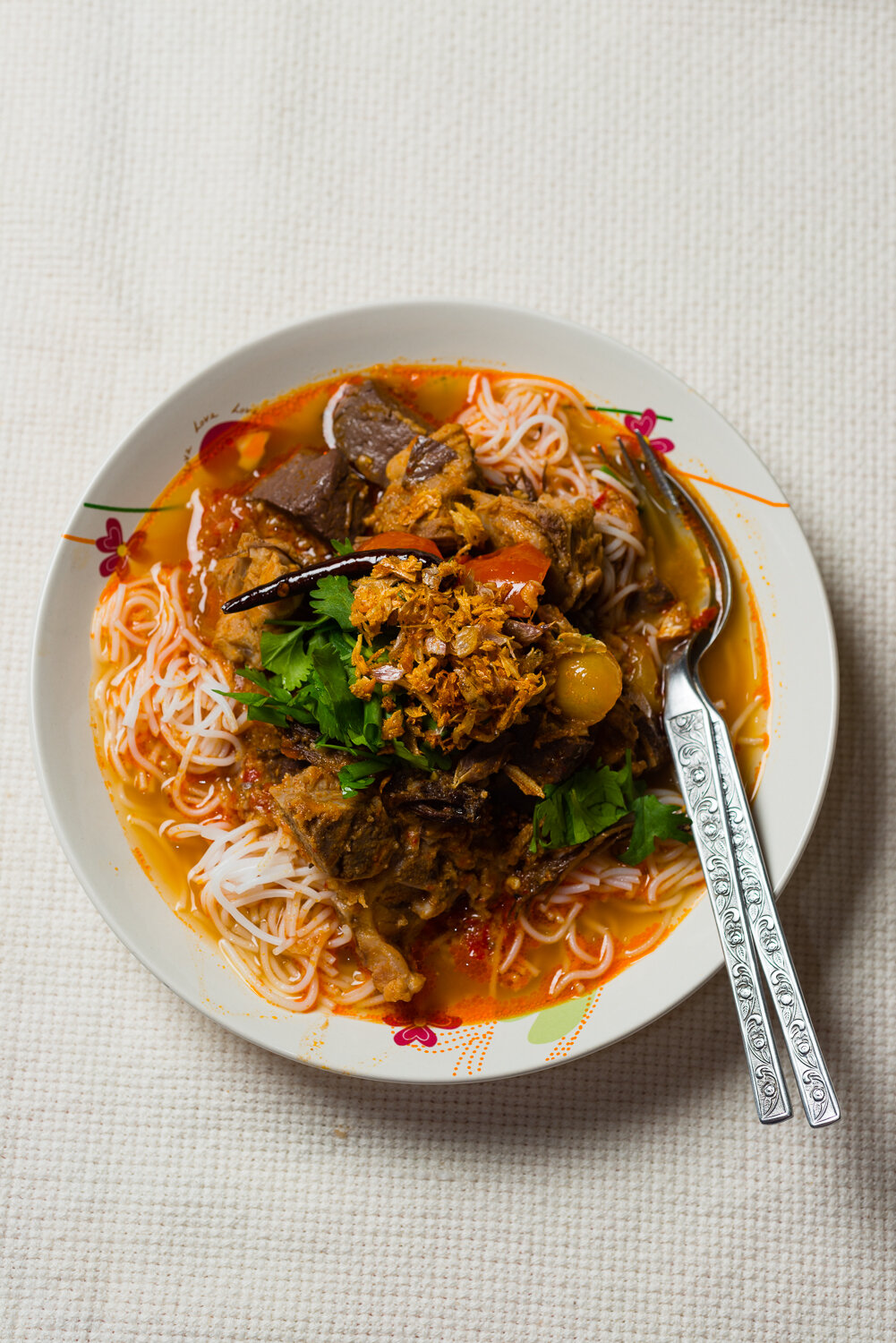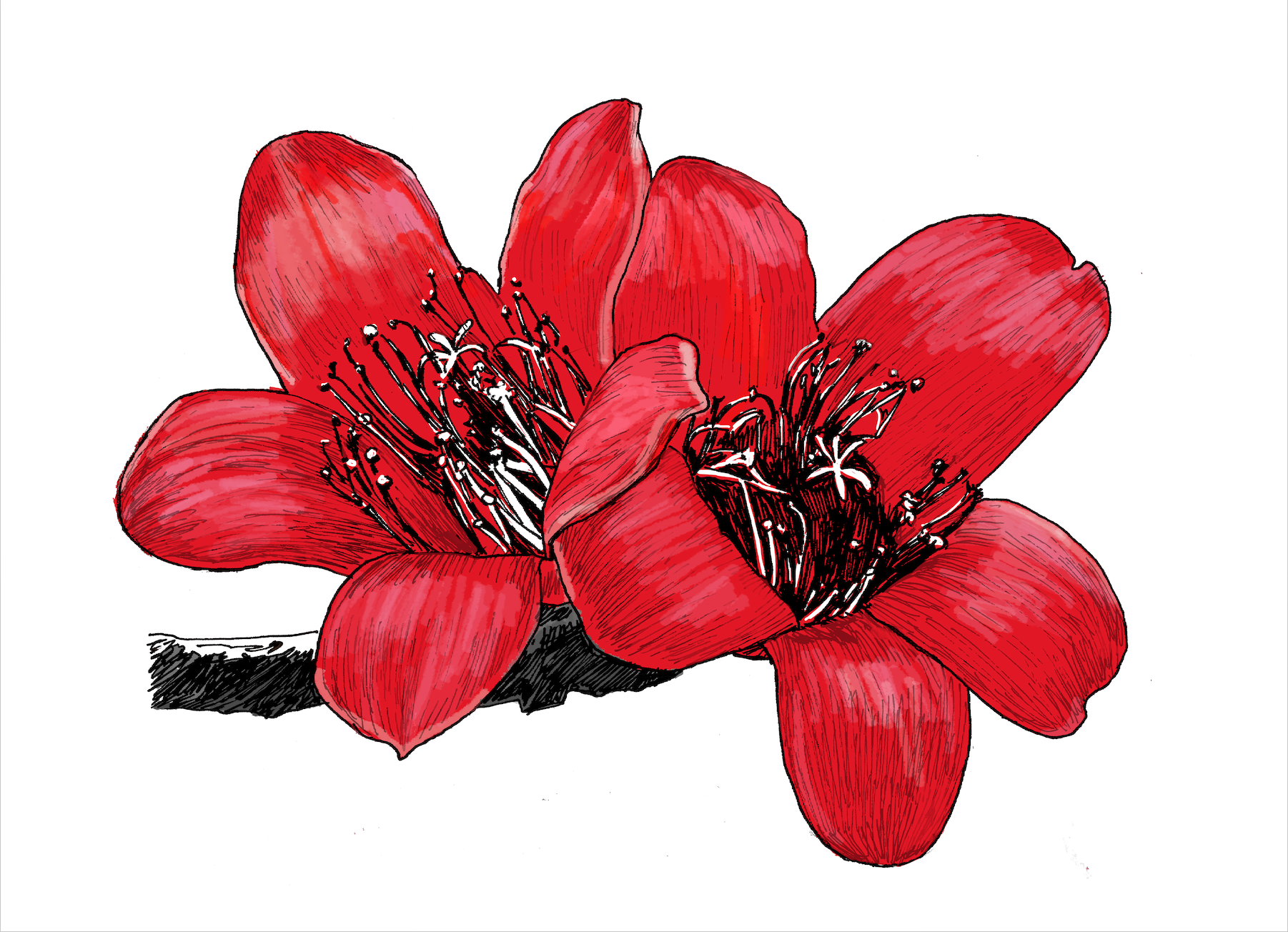Khanom jiin naam ngiaw, a hearty soup of pork ribs and tomatoes served over thin, round rice noodles, is a bona-fide northern Thai classic, easily one of the most beloved dishes in the region. Yet like khao soi, kaeng hang lay, and some of northern Thailand’s other most famous dishes, it’s actually an immigrant.
Ngiaw is a not entirely PC term for the Shan people, an ethnic group closely related to the Thais, suggesting that they had a role in creating or spreading the dish. Today, most Shan reside in Myanmar, but forced immigration and conflict during the 18th and 19th centuries meant that they crossed to northern Thailand in great numbers, bringing with them their cuisine. Yet as khanom jiin naam ngiaw spread across northern Thailand it took varying forms: in Chiang Rai, the dish is typically rich and oily, and is sometimes made with beef; in Mae Hong Son, locals prefer a thin, tart broth with little or no meat; while in Phrae and Nan, the soup is clear, fragrant and overtly porky.
“It has to have cotton tree flowers and blood,” offers Areerat Chowkasem, a Mae Rim-based cook and the source of this recipe.
Areerat is describing her take on Chiang Mai-style khanom jiin nam ngiaw, which with its precise balance of meaty, tart and salty flavors, has come to be regarded as the standard across northern Thailand. Its restrained heartiness stems from a combination of tender pork ribs and disks of dried, fermented soybeans. Tart tomatoes, stewed until soft yet not entirely disintegrated, serve to boost the umami, their acidity also functioning to cut through all that meatiness. And of course there’s those two unusual ingredients.
Areerat tells me that, in the past, raw blood was added directly to the soup as a thickener, but today it’s included in the form of tender, steamed cubes. Cotton tree flowers, she explains, are there for one reason alone: “They’re chewy.”
As is the case across the region, a bowl of Chiang Mai-style khanom jiin nam ngiaw is garnished with crispy garlic and garlic oil, and is served with deep-fried dried chilies, two ingredients that feature in several other northern Thai dishes with likely Shan origins. This recipe yields a generous portion of crispy garlic and garlic oil, which can be sealed tightly, refrigerated for months and used with a variety of other recipes.
Note that fresh khanom jiin noodles are generally not available outside of Southeast Asia. As a substitute, Andy Ricker of Pok Pok suggests using fine-gauge dried bún, Vietnamese rice noodles, following the cooking instructions on the package.
Khanom Jiin Naam Ngiaw
ขนมจีนน้ำเงี้ยว
Chiang Mai-style pork rib and tomato broth served over thin rice noodles
Serves 4-6
Ingredients
For the Crispy Garlic and Garlic Oil
100 small cloves garlic (approximately 100 grams total)
2 cups vegetable oil
For the Crispy Dried Chilies
20 medium dried chilies (approximately 10 grams total)
4 tablespoons vegetable oil
For the Curry Paste
½ teaspoon salt
20 medium dried chilies (approximately 10 grams total)
6 shallots, (approximately 50 grams total), peeled and sliced
30 small garlic cloves (approximately 25 grams total)
1 tablespoon shrimp paste
For the Soup
2 fermented soybean disks (approximately 30 grams total)
2 tablespoons garlic oil
1 kilogram/2½ pounds pork back ribs, chopped into segments about 1½ inches wide
20 dried cotton tree flowers (approximately 7 grams total), boiled for 15 minutes or until tender
3 tablespoons Thai-style salted fermented soybeans/fermented soybean paste
400 grams chicken blood cake, cut in cubes approximately ½ inch square
25 tart cherry tomatoes (approximately 200 grams total), halved
4 medium tomatoes (approximately 200 grams total), quartered
Garnishes & Sides
200 grams pickled mustard greens, chopped
1 small head cabbage (approximately 200 grams), shredded finely
150 grams mung bean sprouts
4 limes, cut into wedges
fish sauce
600 grams/1½ pounds khanom jiin noodles
2 small bunches green onion (approximately 40 grams total), chopped
4 small bunches cilantro (approximately 20 grams total), chopped
Thai Kitchen Tools
granite mortar and pestle
medium (approximately 12-inch) wok
Procedure
A day or two in advance, make the crispy garlic and garlic oil, the crispy dried chilies and the curry paste.
Make the crispy garlic and garlic oil: To a granite mortar and pestle, add the garlic. Pound and grind until all the cloves have been smashed and have a coarse, rough consistency just short of a paste. To a wok over medium-low heat, add the garlic and vegetable oil. Bring to a low simmer and fry, stirring occasionally, until the garlic is fragrant, golden and crispy, which can take between 20 and 30 minutes. Keep the garlic and oil mixture in a glass jar at room temperature.
Make the crispy dried chilies: To wok over low heat, add the dried chilies and vegetable oil. Fry, stirring occasionally until the chilies are fragrant, dark red (but not black) and just beginning to crisp, about 5 minutes. Remove the chilies from oil and allow to drain on a paper towel. When cool, keep the chilies in a sealed container at room temperature.
Make the curry paste: To a granite mortar and pestle, add the salt and medium dried chilies. Pound and grind to a coarse powder. Add the shallots and garlic, pound and grind to a coarse paste. Add the shrimp paste, pound and grind to a fine paste.
On the day of serving, make the soup: Over a flame or coals (or in a toaster), toast the fermented soybean disks until golden in color, fragrant and uniformly blistered. When cool enough to handle, add to a mortar and pestle and grind to a powder. To a medium sized stockpot over medium heat, add the oil and curry paste. Fry 1 or 2 minutes, until fragrant and combined with oil. Add the pork ribs, stirring to combine. Add the cotton tree flowers and enough water to just cover the ribs (approximately 2 quarts of water). Increase heat to medium-high and bring to the boil, maintaining soup at a relatively aggressive simmer. Add the fermented soybean paste and fermented soybean disk powder. Close the lid and allow to simmer approximately 10 minutes. Remove the lid, add the blood and tomatoes. Allow to simmer, uncovered, another 15 to 20 minutes, or until the pork ribs are tender, the tomatoes are soft, a thin layer of oil has risen to the top, and the mixture is fragrant. Taste, adjusting seasoning if necessary; the nam ngiaw should taste overtly umami, slightly spicy and tart.
To a shallow bowl or deep plate, add approximately 100 grams of khanom jiin noodles and top with approximately 1 cup of the soup. Garnish with green onion, cilantro and crispy garlic and garlic oil. Serve khanom jiin nam ngiaw hot, with optional sides.














